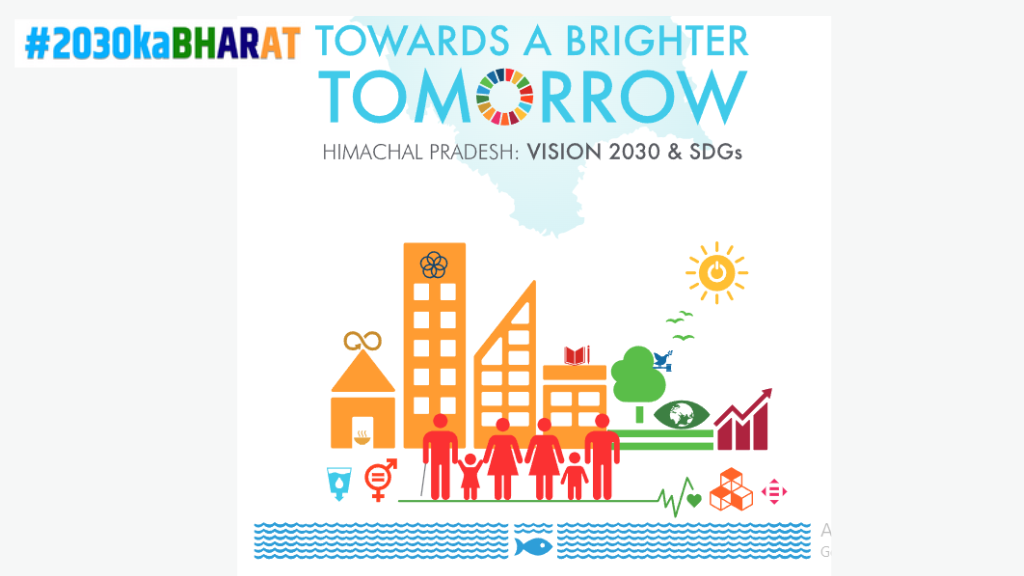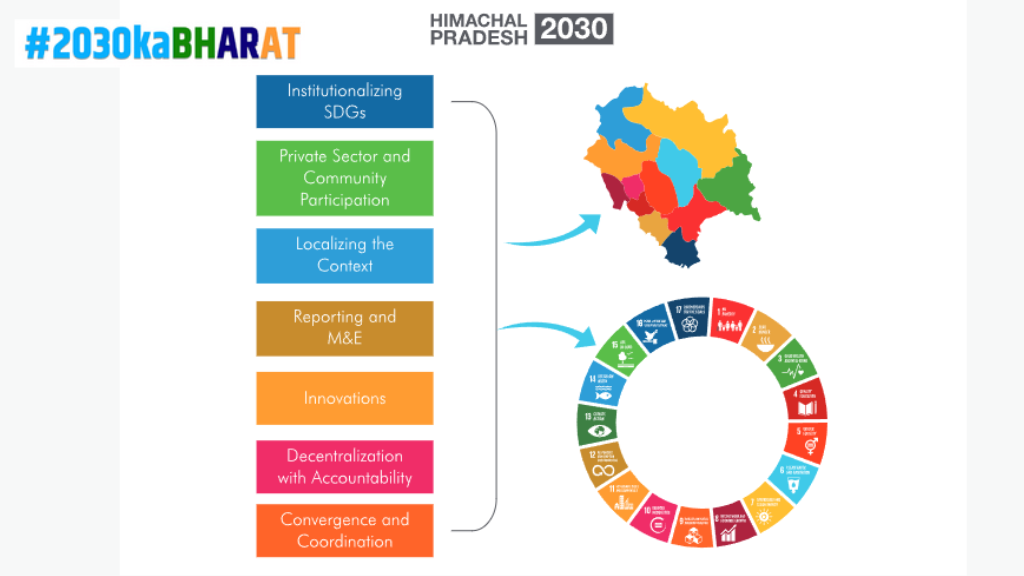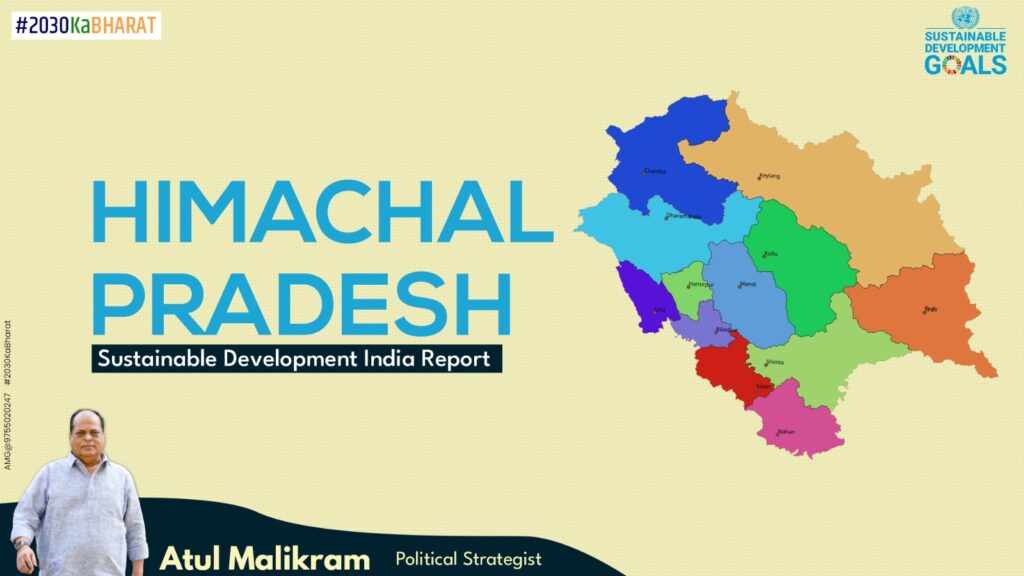Himachal Pradesh Sustainabe Development: Introduction
Sustainable development is not merely a buzzword but a guiding principle that shapes the trajectory of nations and regions towards a harmonious coexistence of economic prosperity, social equity, and environmental preservation. In the heart of India, Himachal Pradesh stands as a testament to dedicated efforts in aligning development goals with sustainability. This article delves into the nuances of the “Himachal Pradesh Sustainable Development India Report,” unraveling the journey, achievements, and challenges faced by the state in its pursuit of the Sustainable Development Goals (SDGs).

II. Background
Nestled in the Himalayas, Himachal Pradesh boasts a unique topography that has both fueled and posed challenges to its development. With a composite score of 74, securing the second rank in the country, the state has emerged as a frontrunner in India’s sustainable development landscape. This score is a reflection of the state’s commitment to balancing economic growth, social inclusion, and environmental protection.
Historically, Himachal Pradesh has been at the forefront of sustainable development initiatives. From early investments in renewable energy to the preservation of its rich biodiversity, the state has embraced a holistic approach to growth. Key sectors such as tourism, agriculture, and healthcare have played pivotal roles in contributing to the impressive composite score.
III. Methodology
The calculation of the composite score involves a meticulous methodology that considers a myriad of indicators. Drawing on data from reputable sources such as the NITI Aayog’s SDG India Index, the assessment is comprehensive and reflective of the multi-dimensional nature of sustainable development. Collaboration with academic institutions, local authorities, and NGOs has facilitated robust data collection and analysis.
IV. Key Achievements
Himachal Pradesh’s sustainable development journey is adorned with notable achievements. The state’s commitment to renewable energy is exemplified by its hydropower projects, contributing significantly to the national grid. With advancements in sustainable agriculture practices, the state has not only ensured food security but has also empowered local farmers economically.
The implementation of eco-friendly tourism practices has not only attracted global attention but has also preserved the pristine beauty of the Himalayas. The success stories extend to education and healthcare, with the state achieving remarkable progress in ensuring access to quality services for its residents.
V. Challenges and Opportunities
However, the path to sustainable development is not without challenges. Himachal Pradesh faces issues such as deforestation, waste management, and disparities in development across regions. Addressing these challenges requires a nuanced approach, involving community participation, technological innovation, and policy interventions.
The challenges present opportunities for growth and improvement. Integrating technology into waste management, investing in sustainable forestry practices, and bridging the development gap between urban and rural areas are avenues that, if explored, can further elevate Himachal Pradesh’s sustainable development journey.

VI. Case Studies of Himachal Pradesh Sustainable Development
Case Study 1: Renewable Energy Revolution in Lahaul-Spiti District
One of the standout success stories in Himachal Pradesh’s sustainable development journey is the transformation of Lahaul-Spiti, a remote district in the state, through a renewable energy revolution. Lahaul-Spiti, known for its challenging terrain and harsh climate, faced energy scarcity for years. Traditional energy sources were not only unreliable but also posed environmental risks. The government, in collaboration with local communities and international organizations, initiated a comprehensive renewable energy project.
- Background: Lahaul-Spiti, situated at high altitudes, had limited access to conventional energy sources. The project aimed to address this challenge by harnessing the region’s abundant solar and wind resources. The objective was to provide a reliable and sustainable energy source to meet the needs of the local population while reducing dependence on fossil fuels.
- Implementation: The project involved the installation of solar panels and wind turbines strategically placed to maximize energy capture. Additionally, a microgrid system was established to ensure efficient distribution and storage of the generated energy. Local communities actively participated in the project, with training provided for maintenance and operation of the renewable energy infrastructure.
- Achievements: The Lahaul-Spiti renewable energy project has yielded remarkable results. The district now boasts a reliable and continuous power supply, reducing the dependency on traditional energy sources. The initiative has not only improved the quality of life for residents but has also had a positive impact on the environment by reducing carbon emissions.
- Challenges and Lessons Learned: While the project has been successful, it was not without challenges. The harsh weather conditions posed logistical and technical challenges during implementation. However, through adaptive strategies and community engagement, these challenges were overcome. The case study highlights the importance of tailoring sustainable solutions to the unique challenges of each region and the pivotal role of community involvement in ensuring the success and sustainability of such initiatives.

Case Study 2: Community-Driven Waste Management in Shimla
Shimla, the capital city of Himachal Pradesh, faced a growing challenge of waste management due to rapid urbanization and an increasing population. In response, the city implemented a community-driven waste management model that not only addressed the waste issue but also fostered a sense of responsibility and environmental consciousness among residents.
- Background: Shimla’s waste management model was designed to involve the community actively. The objective was to reduce the generation of waste through awareness programs, promote recycling and segregation at source, and ensure the proper disposal of residual waste in an environmentally friendly manner.
- Implementation: The initiative began with extensive awareness campaigns to educate residents about the impact of improper waste disposal. Segregation bins were distributed, and community members were trained on the importance of separating recyclables from non-recyclables. Local self-help groups were also involved in setting up small-scale recycling units.
- Achievements: The community-driven waste management model has significantly reduced the overall waste generated in Shimla. Recycling rates have increased, leading to a decrease in the burden on landfills. Additionally, the initiative has empowered local communities, providing economic opportunities through small-scale recycling enterprises.
- Challenges and Lessons Learned: The success of the waste management model in Shimla was not immediate. Resistance to change and ingrained habits posed initial challenges. However, sustained efforts in community engagement, coupled with visible improvements in cleanliness and environmental impact, gradually garnered support. This case study underscores the importance of behavioral change in sustainable development initiatives and the need for persistent community engagement.
These case studies from Lahaul-Spiti and Shimla exemplify Himachal Pradesh’s commitment to addressing unique challenges through innovative, community-driven, and sustainable solutions. They showcase the state’s ability to adapt to local contexts while making significant strides towards achieving SDGs.

VII. Comparison with National and Global SDG Trends
A comparative analysis with national and global SDG trends showcases Himachal Pradesh’s exemplary performance. The state’s progress in clean energy aligns with India’s commitment to the Paris Agreement. Moreover, its success in reducing poverty and ensuring gender equality positions it as a model for other states to emulate.
On the global stage, Himachal Pradesh’s efforts contribute significantly to achieving the United Nations’ 2030 Agenda for Sustainable Development. Lessons learned from the state’s initiatives can inspire international collaborations and partnerships aimed at achieving common SDG objectives.
VIII. Community Engagement and Inclusivity
A distinguishing feature of Himachal Pradesh’s sustainable development approach is the active involvement of its communities. Local residents actively participate in decision-making processes, ensuring that development initiatives are culturally sensitive and socially inclusive. Case studies from various regions underscore the success of community-driven projects, emphasizing the importance of grassroots involvement in sustainable development.
IX. Future Roadmap
The path forward for Himachal Pradesh involves a concerted effort from various stakeholders. A long-term vision that integrates economic growth with environmental preservation is crucial. Policy recommendations include the integration of sustainable practices into urban planning, the promotion of green technologies, and targeted interventions to address regional disparities.
Stakeholders, including the government, non-governmental organizations, businesses, and the community, must collaborate to implement these recommendations. This collaborative approach will not only solidify Himachal Pradesh’s position as a leader in sustainable development but will also set a precedent for other regions to follow suit.
X. Conclusion
In conclusion, the “Himachal Pradesh Sustainable Development India Report” paints a picture of success, resilience, and commitment. The state’s journey towards achieving the SDGs serves as a beacon for others, demonstrating that sustainable development is not just an aspiration but an achievable reality. As Himachal Pradesh continues to stride towards a harmonious future, it leaves behind a legacy of balanced growth that the rest of the world can learn from and replicate.
Resources:
Indian State Rank In SDG Goals
Himachal Pradesh State Government. “Annual Report on Sustainable Development Goals Implementation
